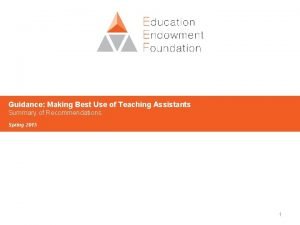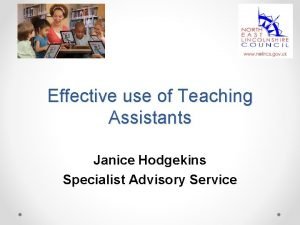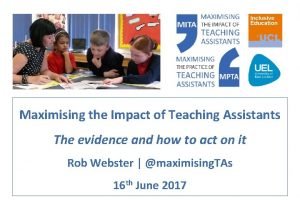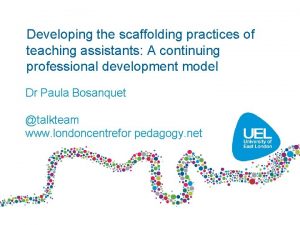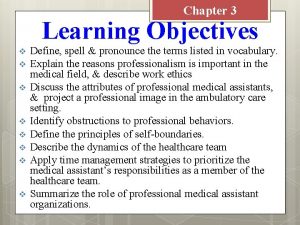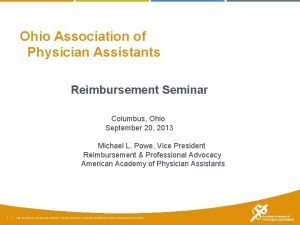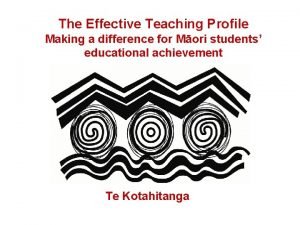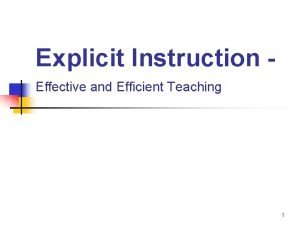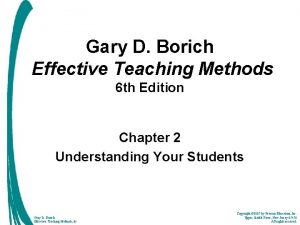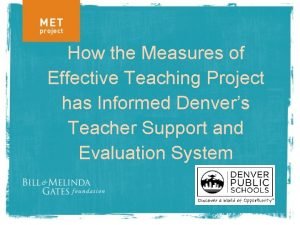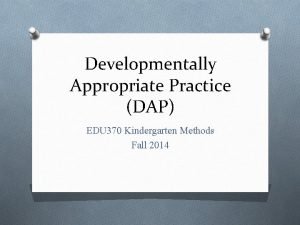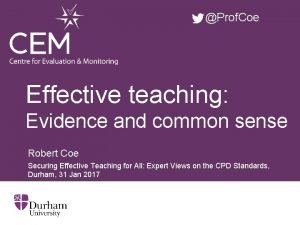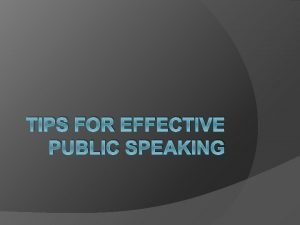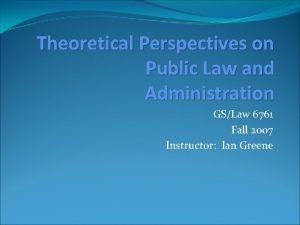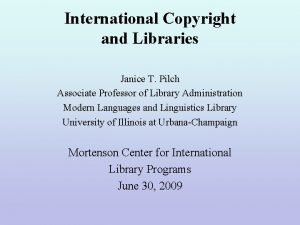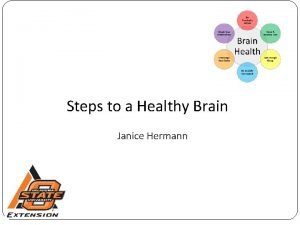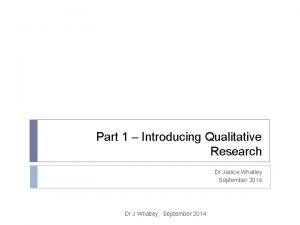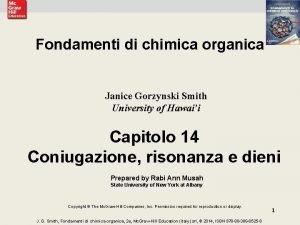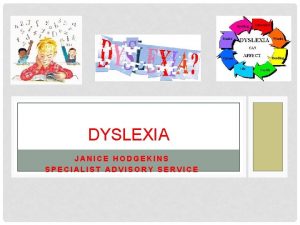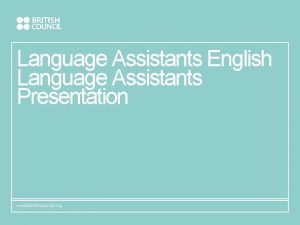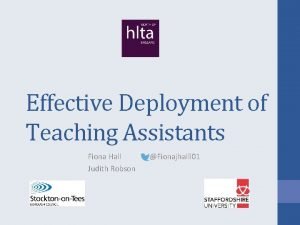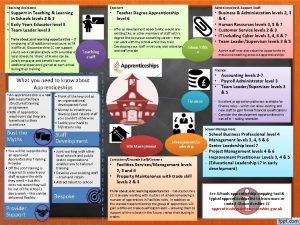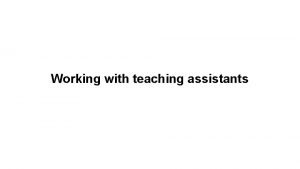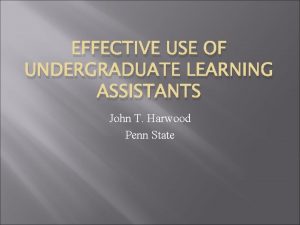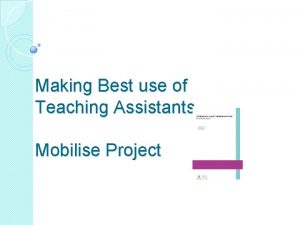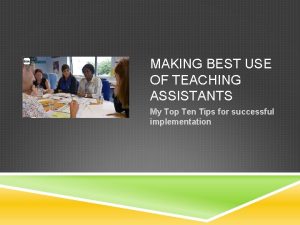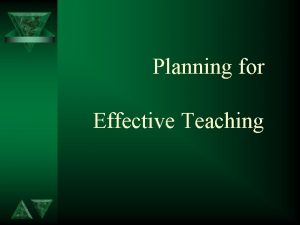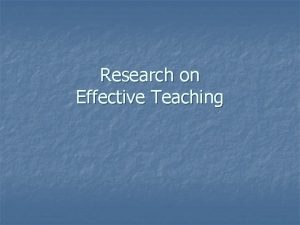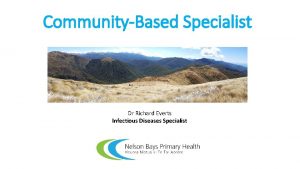Effective use of Teaching Assistants Janice Hodgekins Specialist






















- Slides: 22

Effective use of Teaching Assistants Janice Hodgekins Specialist Advisory Service

3 Main Types of Support • 1. Non- pedagogic support • 2. Pedagogic support • 3. Support for the whole school

Research • DISS Project 2003 -2009 • EDTA Project 2011 • Sutton Trust Toolkit 2013 • Education Endowment Foundation 2015

DISS project – Key Findings Positives: TAs: ü Help ease teacher workload and stress ü Reduce classroom disruption ü Allow teachers more time to teach ü Help pupils with behaviour and attention problems to develop confidence, improved motivation, good working habits and willingness to complete tasks.

DISS Project-Key Findings • Negatives: • TAs spend most of their time working with pupils with SEN and hardly any working with average or higher attaining pupils. • TAs are more concerned with task completion and less concerned with developing understanding and learning. • Dependence is increased while ability to work and learn independently is decreased • TAs are not adequately prepared and have too little time for liaison with teachers.

DISS Project-Key Findings Negatives • Those pupils receiving the most support from TAs made less progress than similar pupils who received little or no TA support. • The negative impact was most marked for pupils with the highest level of SEN (EHCPs) who typically receive most TA support.

So, what now? • Not the TAs fault. • EEF 380, 000+ TAs • The status quo is not an option. Focus on outcomes not hours of TA support. • Poor TA deployment has a negative impact on attainment; effective TA deployment can have positive impacts • Partnership between teacher and TAs. Immediate and focused support • Overcome barriers by investing time, attention and effort not money • Up-skill TAS. Improving use of current TAs better use of funds than employing more. • Use the free guidance and resources available

• All pupils will benefit Why? • TAs feel more valued and able to do their job. Raises status. • Average school spend is about £ 200, 000 per year • Making best use of TAs is consistent with schools’ obligations under the Code of Practice • Contributes to an OFSTED grading. Inspectors are increasingly looking at how TAs are deployed and the value they add (or not) to attainment.

Sorting Activity Work through the statements and choose one thing TAs should always do and one thing they shouldn’t. Feedback

Making Best Use of Teaching Assistants • Guidance Report • EEF -2015 • Seven recommendations divided into three sections: 1. Everyday classroom contexts 2. Structured interventions outside of class 3. Linking learning from work led by teachers and TAs

1. Everyday Classroom Contexts • TAs should not be used as an informal teaching resource for low attaining pupils. • TAs should not be used just so that children can complete the task.

2. Everyday Classroom • Use TAs to add value to what teachers do, not replace them. • Supplement not replace • Teacher not TA time • Access to HQT • Avoid separation • Avoid dependency

3. Everyday Classroom • Use TAs to help pupils develop independent learning skills and manage their own learning. • ‘. . . the value of the TA role is not in task management and completion but in helping and prompting pupils to work things out for themselves. . . ’ (DISS Project)

4. Everyday Classroom • Ensure TAs are fully prepared for their role in the classroom. • Training- effective CPD • Effective communication and liaison • Time for preparation and feedback

5. Structured Interventions • Use TAs to deliver high quality 1: 1 and small group support using structured interventions. • Structured settings • Training

6. Structured Interventions • Adopt evidence based interventions to support TAs in their small group and 1: 1 instruction. • Reliable evidence of effectiveness • Timetabled • Appropriate

Good Practice- Interventions • • • Brief sessions of 20 -50 minutes Regular sessions of 3 - 5 x per week Maintained over a period of time 8 -20 weeks Delivery remains constant TA Training is high quality and lasts for 5 -30 hours per intervention Structured interventions which follow the programme carefully Supporting resources and lesson plans included Assessment is used to identify pupils and track progress Connections are made between the intervention and classroom work Liaison with the class teacher

7. Linking Learning • Ensure explicit connections are made between learning from everyday classroom teaching and structured interventions. • Consistent • Extension

IMPACT • I Provide INTERVENTIONS with clear planning, resources and expected outcomes. • M MAKE LINKS between intervention work and classroom based learning • P PREPARE TAs for the content of lessons, what they need to know and what they need to do • A ASK for feedback about the progress of children against intended learning outcomes • C CHANGE classroom practice so that TAs are not always supporting the lower attaining pupils • T Provide TRAINING in delivering interventions AND pedagogical classroom practice

Over to You In Pairs: Think about the 7 recommendations. • As a school what are your strengths? • What are your weaknesses?

AUDIT & ACTION • Where are you now? • Where do you want to go next? 1. 2. 3. 4. 5. Conduct audit- draw up action plan Define purpose of TA role- TA/teacher agreement Develop school policy and models of practice Provide training and preparation time Review & change • Workshops

Further Reading • Maximising the Impact of Teaching Assistants – Rob Webster, Anthony Russell & Peter Blatchford (2016) • The Teaching Assistants Guide to Effective Interaction – Paula Bosanquet, Julie Radford & Rob Webster (2016) • Making Best use of Teaching Assistants (EEF)- Jonathan Sharples, Rob Webster & Peter Blatchford(2015) • www. educationendowmentfoundation. org. uk • Teaching Assistants-A Guide to good practice (Oxford School Improvement) www. oxfordprimary. co. uk • Resources to support with review and examples of effective practice: www. sendgateway. org. uk • You Tube: search Rob Webster Teaching Assistants (Video of presentation to NASEN on the DISS report). • Review and guidance docs to download: http: //maximisingtas. co. uk/resources. php
 Making best use of teaching assistants
Making best use of teaching assistants Hodgekins disease
Hodgekins disease Maximising the impact of teaching assistants
Maximising the impact of teaching assistants Scaffolding framework for teaching assistants
Scaffolding framework for teaching assistants Having a courteous conscientious and respectful approach
Having a courteous conscientious and respectful approach Ohio association of physician assistants
Ohio association of physician assistants Difference
Difference Examples of explicit instruction
Examples of explicit instruction Ethurom
Ethurom 10 principles of effective online teaching
10 principles of effective online teaching Measures of effective teaching project
Measures of effective teaching project Dap kindergarten
Dap kindergarten Effective teaching evidence and practice
Effective teaching evidence and practice Youtube jerry seinfeld public speaking
Youtube jerry seinfeld public speaking Janice gross stein
Janice gross stein Janice pilch
Janice pilch Fearless by janice galloway
Fearless by janice galloway Janice li stanford
Janice li stanford Janice joneja
Janice joneja Janice hermann
Janice hermann Research onion
Research onion Majapahit kingdom map
Majapahit kingdom map Janice gorzynski smith
Janice gorzynski smith
